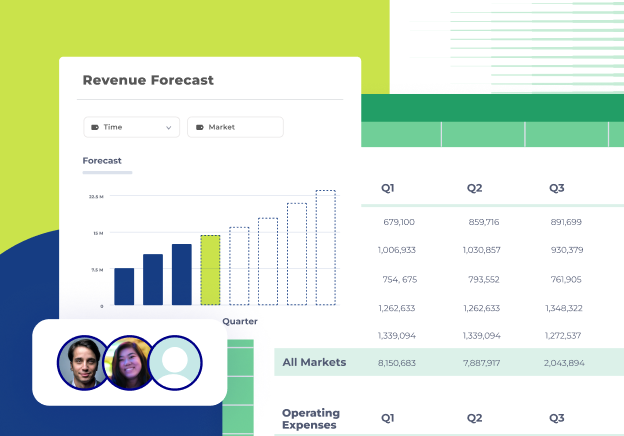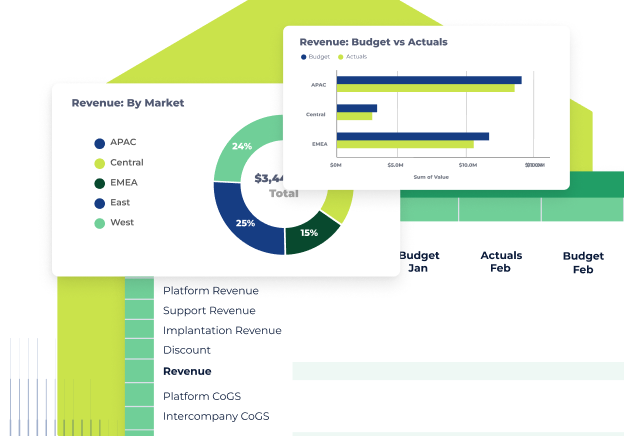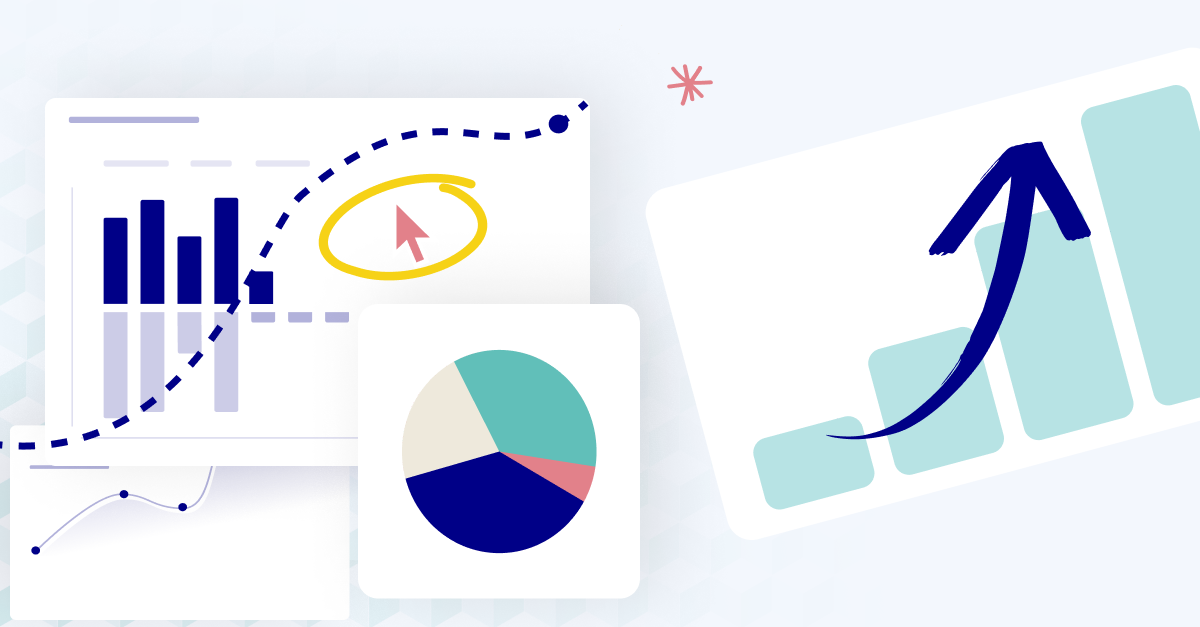The new wave of profitability analysis
Profitability analysis has come a long way, transforming from basic number-crunching to a key strategic asset. It's not just about tracking profits anymore; it's about understanding them and making them grow. This shift means using real-time financial and operational data to get a clear picture of where your money is made and lost.
For SMBs, every penny counts—which is why profitability analysis software is crucial. It helps you understand your finances in detail, allowing you to make decisions that can really boost your bottom line. It helps in striking the right balance between immediate financial concerns and long-term growth.
What are profitability software tools?
Profitability software helps companies analyze revenue, costs, and profit margins to identify the most and least profitable areas. Unlike manual spreadsheets, these tools can automate calculations, track performance in real time, and flag inefficiencies.
Businesses can use profitability tools to optimize pricing, cut unnecessary costs, and make smarter financial decisions without relying on complicated formulas or external analysts.
Here are some key ways profitability analysis software can be a game-changer for your business:
- A better understanding of financial health: You can gain a clear view of your business’s profitability landscape. This means knowing your income and understanding your costs in-depth.
- Informed decision-making: The software turns complex financial data into actionable insights. This helps you make informed decisions about where to cut costs, where to invest, and how to drive profit growth.
- More strategic planning for business growth: While it’s essential for your day-to-day decisions, this tool also plays a big role in your long-term strategy. It guides you in planning for sustainable growth by showing you the most profitable paths for your business.
In short, profitability analysis software is like having a financial co-pilot, guiding you through the complexities of managing your business’s profits, helping you make informed decisions, and setting you up for long-term success.

Profitability analysis software features that enhance your bottom line
Profitability analysis software goes beyond traditional financial reporting. It allows you to dive deep into your revenue streams and costs, using various data points—from sales figures to operational expenses. By inputting these variables, the software helps paint a detailed picture of your profitability landscape, helping you to understand the story behind the numbers.
Here are some of the key features of profitability analysis software that are most beneficial for SMBs:
- Detailed profitability insights: Access real-time data that breaks down profits by product, service, or customer segment. This helps in identifying which areas are most profitable and which need tweaking.
- Seamless integration with existing systems: By syncing with your current accounting and sales systems, the software can aggregate data, offering a unified view of your financial health.
- Automated reporting and analysis: Save valuable time with automated reports that provide a detailed analysis of profitability metrics. This helps in making quick, data-driven decisions.
- Customizable to your business needs: The software can be tailored to your specific business model, ensuring the insights you receive are directly applicable to your strategic decisions.
- Identifying cost-saving opportunities: Beyond revenue, the software can highlight areas where costs can be reduced without impacting product quality or customer satisfaction.
- Scenario modeling for strategic planning: Profitability analysis software can project future profitability under various business scenarios, aiding in strategic planning.
By integrating these features into your financial strategy, profitability analysis software can help you make informed decisions to optimize your profits and drive your business forward.
How to choose the right profitability analysis software tools for your business
Selecting the ideal profitability analysis software is a vital task for finance leaders aiming to enhance their financial performance. The goal is to find a solution that perfectly balances functionality with ease of use, providing the necessary features without overcomplicating things or limiting your business as it grows. When evaluating software options, here are several key factors to consider:
- Depth of profitability insights: Opt for software that allows you to dive deep into profit margins, cost centers, and revenue streams. It should offer detailed analysis capabilities to identify key profit drivers and areas for improvement.
- Sector-specific functionality: Since different industries have unique financial dynamics, choose software that caters to your specific sector's profitability analysis needs, whether it's retail, manufacturing, or services.
- Data integration and accuracy: The software should efficiently consolidate data from various sources (sales, expenses, overheads) and ensure accuracy, which is crucial for reliable profitability analysis.
- Flexibility in reporting: Look for flexibility in reporting formats and the ability to customize reports to meet your specific needs, whether it's product line profitability, customer segment analysis, or regional performance.
- Ease of collaboration: Since profitability analysis often involves multiple departments, choose software that facilitates easy sharing and collaboration across teams.
- Cost-benefit ratio: Finally, consider the cost of the software against the value it brings in terms of detailed insights and time saved in profitability analysis. It should offer a solid return on investment.
By keeping these considerations in mind, you can choose a profitability analysis software that not only meets your current needs but also serves as a valuable tool for strategic financial planning and analysis as your business evolves.
Best profitability tools for businesses
Now that you understand how invaluable this software can be, let’s look at the best profitability tools for business on the market right now.
1. Cube
.png?width=249&height=72&name=blue-cube-logo%20(1).png)
Cube is a first-of-its-kind spreadsheet-native FP&A platform that gives users enterprise-grade profitability tools in a beginner-friendly package. It uses AI to help businesses track cash flow, model different revenue scenarios, and make informed decisions about pricing, hiring, and investments.
With AI-powered forecasting, Cube simplifies financial planning by eliminating manual data entry, automating reporting, and providing real-time insights into profitability. Business owners can test different “what-if” scenarios—like adjusting prices, expanding to a new location, or hiring new employees—to see the impact before making critical financial decisions.
Cube seamlessly integrates with Excel and Google Sheets, so businesses can work with the tools they already know and trust. Companies like Edge Fitness Club and Smart City use Cube to streamline budgeting, improve forecasting accuracy, and free up time to focus on growth strategies.

Features:
- Revenue forecasting: Predict future income based on historical data and market insights to maximize profitability.
- Scenario planning: Model different business outcomes like pricing changes or hiring decisions to see their impact on profitability before taking action.
- Cash flow tracking: Monitor cash inflows and outflows to measure profitability and prevent cash shortages.
- Expense management: Identify areas of overspending and adjust budgets to protect margins and improve profitability.
- Automated financial reporting: Eliminate manual data entry with real-time financial updates and automated reports to ensure accurate profitability tracking.
- Multi-scenario analysis: Test different growth strategies to determine the most profitable path forward.
- Customizable dashboards: Visualize financial performance with easy-to-use, drag-and-drop dashboards tailored to your business needs.
- AI-powered financial insights: Get proactive recommendations and variance analysis to optimize profitability.
- Spreadsheet-native integration: Work seamlessly in Excel or Google Sheets while leveraging Cube’s automation and forecasting capabilities.
- Seamless data consolidation: Integrate Cube with accounting software, CRMs, ERPs, and other financial tools to ensure all data is up to date.
- Role-based permissions: Control access levels for team members to ensure secure financial collaboration.
- Quick onboarding and support: Get started fast with an intuitive setup and responsive customer support.
Pricing: Custom pricing starts at just $2,000/mo
See Cube in action.

2. Fathom

Fathom is a financial analysis and reporting tool that can help small businesses track profitability, monitor cash flow, and gain financial insights. It integrates with accounting platforms like QuickBooks, Xero, and MYOB to convert raw financial data into visual reports. You can organize these reports into customizable dashboards to make financial decisions.

Features:
- Profitability analysis: Identify which areas of business drive the most profit.
- Cash flow forecasting: Predict future cash inflows and outflows.
- Variance analysis: Compare actual financial performance against budgeted or forecasted numbers.
- Custom KPIs: Set up personalized KPIs.
Pricing:
- Starter: $50/mo
- Silver: $260/mo
- Gold: $380/mo
- Platinum: $680/mo
3. Board

Board is an enterprise planning platform that combines financial planning, budgeting, and profitability analysis. It uses scenario modeling and profitability tracking tools for businesses to adjust financial strategies. It should be noted that Board may be more optimal for enterprises with a larger budget.

Features:
- Automated budgeting and forecasting: Automatically update data entry and financial projections.
- Profitability insights: Track margins, costs, and revenue trends.
- Scenario modeling: Simulate financial outcomes.
- Integrations: Connect financial data from multiple sources.
Pricing: Custom pricing.
4. Quickbooks

QuickBooks is an accounting software developed by Intuit. This software is tailored for the financial management needs of small to medium-sized businesses. Users can analyze the profitability of projects to see which ones make money and which ones lose money.

Features:
- Project profitability tracking: Identify which projects are profitable and which are not.
- Cost tracking calculator: Determine if projects are on budget or require adjustments.
- Integrations: Automatically update labor costs and expenses when connected with QuickBooks Payroll and QuickBooks Time.
- Financial reporting: Access reports on income, expenses, and profitability.
Pricing:
- Simple Start: $35/mo
- Essentials: $65/mo
- Plus: $99/mo
- Advanced: $235/mo
Learn how Quickbooks compares to Netsuite in our in-depth review.
5. Datarails

Datarails is another FP&A platform that helps small and mid-sized businesses with budgeting, forecasting, and financial reporting. Businesses can use it to model different financial scenarios and track metrics on growth and cost management.

Features:
- Data consolidation: Automatically gathers financial data from multiple sources.
- Financial reporting: Create customizable reports to track profitability, expenses, and financial performance.
- ERP-Excel connectivity: Integrate ERP data directly into Excel.
- Scenario analysis: Model different financial scenarios to assess risks.
Pricing: Custom pricing.
6. Workday Adaptive Planning

Workday Adaptive Planning is an enterprise performance management platform that uses AI to streamline profitability analysis. Workday's AI assistant, Illuminate, helps automate and streamline plans, budgets, and forecasts. It can also align headcount, sales, and operational plans after you’ve analyzed profitability.

Features:
- Drag-and-drop report builder: Create and customize financial reports without coding.
- Interactive visualizations: Turn financial data into clear insights.
- Integrations: Connect to Google and Microsoft apps to format reports and drill into details.
- Ad hoc analysis: Perform financial scenario analysis at any time to adapt to changing business needs.
Pricing: Custom pricing.
7. Prophix

Prophix is a financial performance platform that helps businesses analyze profitability with FP&A tools. Users can perform ad-hoc analysis and database analytics to drill down into the transactional details behind financial balances. These reports can be presented to stakeholders to guide strategic decisions.

Features:
- Predictive forecasting: Use historical data to predict future financial outcomes.
- Account reconciliation: Import data, store standardized reconciliation templates, and automate workflows.
- Data integration: Connect Prophix to financial, operational, and business systems.
- Data visualization: Access interactive charts to view data summaries.
Pricing: Custom pricing
8. Jirav

Jirav is an FP&A platform with driver-based forecasting, automated reporting, and scenario planning. It uses these to help accounting firms and SMBs create financial projections. Jirav enables businesses to track profitability metrics and model different financial outcomes.

Features:
- Reporting and dashboarding: Visualize profitability trends and share insights with stakeholders.
- Budgeting: Make real-time adjustments to align financial plans with business goals.
- Forecasting: Predict future revenue, expenses, and cash flow.
- Scenario Planning: Test different business strategies to assess risks or prepare for potential market changes.
Pricing:
- Industry Safari: $20,000
- Strategy Safari: Custom pricing
Profitability analysis: Key focus areas for finance leaders
Steering your company towards business profitability involves more than just keeping an eye on the bottom line. You also need a keen understanding of the factors that can significantly impact your profits. Here are the vital areas where focusing your attention can significantly impact your company's profitability:
Market demand and customer behavior
Staying attuned to market demand and customer preferences is crucial. Shifts in consumer behavior can open new opportunities (such as a surge in demand for eco-friendly products) or pose challenges (like a sudden decline in interest for a previously popular service). Adapting your products or services to meet evolving demands ensures that your business remains relevant and profitable.
Cost management and efficiency
Effective cost control is a cornerstone of profitability. It's essential to regularly review and optimize your operating costs. This might involve renegotiating supplier contracts, investing in technology to automate processes, or finding more cost-effective ways to produce your goods or deliver services.
Pricing strategies
Setting the right price for your products or services is a delicate balance. It involves understanding the market, your competition, and the value your customers place on what you offer. Regularly reviewing and adjusting your pricing strategy can lead to improved profit margins.
Revenue streams and diversification
Relying on a single revenue stream can be a financial risk. Identifying and developing multiple revenue sources can provide a buffer against market fluctuations and ensure a steady flow of income, boosting overall profitability. Explore options like upselling premium services or expanding into complementary product lines to create new income streams. Align these upsells with customer needs and pain points to maximize profitability.
Financial performance analysis
Regular analysis of financial performance using profitability analysis software helps in understanding which areas of your business are most profitable and which need improvement. This analysis should guide your strategic decisions, from resource allocation to investment planning. Track metrics like gross margin, operating costs, and cash flow to have the whole picture before making any major decisions. Proper analysis also helps identify problematic patterns faster and adjust strategies before financial risks emerge.
Competition analysis
Keeping an eye on the competition helps you stay ahead. Understanding their strategies, strengths, and weaknesses can provide insights into market gaps and opportunities for your business to increase profitability. You can conduct regular competitive benchmarking to assess pricing strategies, marketing approaches, and product positioning. This allows for smarter differentiation—through better offerings, service, or cost —that give you a competitive edge.
Regulatory compliance and tax efficiency
Staying on top of regulatory changes and tax obligations can prevent costly penalties and optimize your tax position, positively impacting your profitability. Tax planning strategies—like leveraging deductions or structuring expenses efficiently—can reduce tax liabilities and free up cash for reinvestment. Partner with a tax professional so your business stays legally compliant while maximizing financial benefits.
By focusing on these areas, finance leaders can guide their SMBs toward greater profitability, ensuring decisions are made with a clear understanding of their impact on the business’s financial success.
Best practices in profitability analysis for finance leaders
Effective profitability analysis is crucial for finance and FP&A leaders looking to drive their organization’s financial performance. Here are some best practices to ensure your analysis is both effective and actionable:
1. Conduct regular and comprehensive reviews
Going beyond annual or quarterly reviews, it's important to regularly analyze profitability data to stay ahead of the curve. This frequent review helps in identifying trends and anomalies early, allowing for swift strategic adjustments that can impact your bottom line positively. It’s about staying proactive rather than reactive in your financial strategy.
2. Consider segmented analysis
Diving into segmented analysis allows a granular view of your financial performance. By evaluating profitability across different dimensions—be it product lines, customer demographics, or regional markets—you gain a clearer understanding of what works and what doesn’t. This level of detail is crucial for making informed decisions about resource allocation and strategic direction.
3. Incorporate both direct and indirect costs
A comprehensive view of profitability includes all forms of costs. Direct costs are straightforward, but indirect costs, like overheads and administrative expenses, can often be overlooked. Accurately accounting for these ensures you’re seeing the true profitability of your business operations, leading to more informed pricing and budgeting decisions.
4. Benchmark against industry standards
Comparing your financial metrics with industry benchmarks provides a reality check on your company's performance. It helps in understanding where you stand in the competitive landscape and can uncover areas where there is room for improvement. This practice also aids in setting realistic and competitive goals for your organization.
Common profitability analysis pitfalls to avoid
Profitability analysis is a powerful tool for finance leaders, but it comes with certain challenges. Being aware of these pitfalls and knowing how to avoid them can significantly enhance the effectiveness of your analysis.
Overlooking external factors
It's crucial not to focus solely on internal financial data. External factors such as market trends, economic shifts, and competitive dynamics can greatly impact profitability. Ensure that these elements are factored into your analysis for a comprehensive view.
Relying on inaccurate or outdated data
The accuracy of your profitability analysis hinges on the quality of the data used. Relying on outdated or incorrect data can lead to misguided strategies. Regularly update your data sources and verify their accuracy to ensure reliable analysis. The right profitability analysis software can also help you ensure your data is clean and up-to-date.
Neglecting long-term trends for short-term gains
While short-term profitability is important, it shouldn't overshadow long-term financial health. Avoid making decisions that boost immediate profits at the expense of sustainable growth. Strive for a balance that supports long-term business objectives.
Failure to adapt
Business environments are dynamic, and sticking rigidly to old models can be detrimental. Be open to adapting your profitability analysis methods as your business and the external environment evolve. Regularly review your financial data, test new forecasting models, and stay informed on industry trends so you can pivot when needed.
Ignoring non-financial factors
Profitability is not solely a function of financial inputs and outputs. Non-financial factors like customer satisfaction, employee morale, and brand reputation also play a significant role. Integrating these qualitative aspects can provide a more holistic view of your business’s health.
Conduct proficient profitability analysis with the best profitability tools
Profitability analysis stands as a cornerstone for SMBs, offering a clear view of where and how profits are generated. It enables informed decisions that propel business growth, and FP&A leaders play a pivotal role in steering these efforts.
To learn how Cube can help you plan for success, request a free demo today.




.png)









.png)

.png)

.png?width=249&height=72&name=blue-cube-logo%20(1).png)





.png)

-1.png)